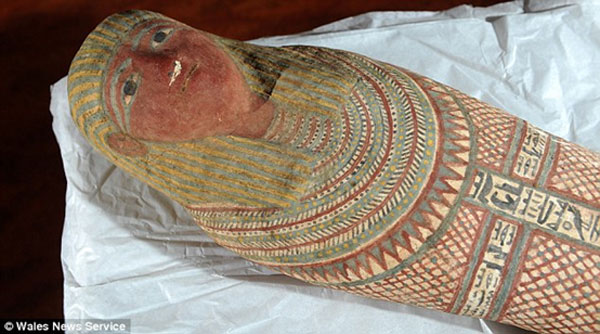Infant-sized ancient Egyptian sarcophagus found to contain mummified foetus
An infant-sized ancient Egyptian sarcophagus with an unknown history has sat on display at an Egypt centre in Wales for some time, with most believing it a forgery, due to inconclusive x-rays carried out over a decade ago, along with unusual inscriptions painted on the case. However, scientists were surprised when new CT scans detected a tiny foetus inside.
The 20-inch (52cm) mummy is part of the Wellcome collection at Swansea University’s Egypt Centre and is thought to date back to the 26th Dynasty - around 600BC, however, nothing is known about where Wellcome obtained it.
X-rays carried out in 1998 did not reveal anything inside and the inscriptions painted on the sarcophagus are meaningless, leading some to believe that the mummy was a 19 th century forgery. However, last month, Swansea University’s Paola Griffiths of the Clinical Imaging College of Medicine, CT scanned the artefact and found that, although the majority of the interior is taken up by linen bandages, there was a tiny dark area measuring 3-inches long, which researchers identified as a foetus attached to a placental sac. Its size is consistent with a foetus that was around 12 weeks into development.

A CT scan shows a tiny foetus inside the sarcophagus. Image credit: Wales New Service
The scan also revealed what appears to be an amulet and strings of beads or tassels. Although the sex of the foetus cannot be determined from the scan, experts believe it is a boy based on the reddish-brown painted face of the sarcophagus and yellow and blue striped wig and wide collar, which are most common on male coffins.
The unreadable inscriptions on the coffin suggests that the sarcophagus was made by someone who could not read and write.
“It’s not unusual for sham hieroglyphs to be placed on coffins. Undoubtedly this would indicate that the maker of the piece was not literate,” curator Carolyn Graves-Brown told Discovery News.
Despite the high infant mortality rate thousands of years ago, the rare discovery reveals that the deaths of infants and even foetuses were not treated casually. Rather great care was taken to ensure they received the proper burial rites according to the beliefs of the time.
Featured image: The sarcophagus of the tiny foetus. Photo credit: Wales News Service



















